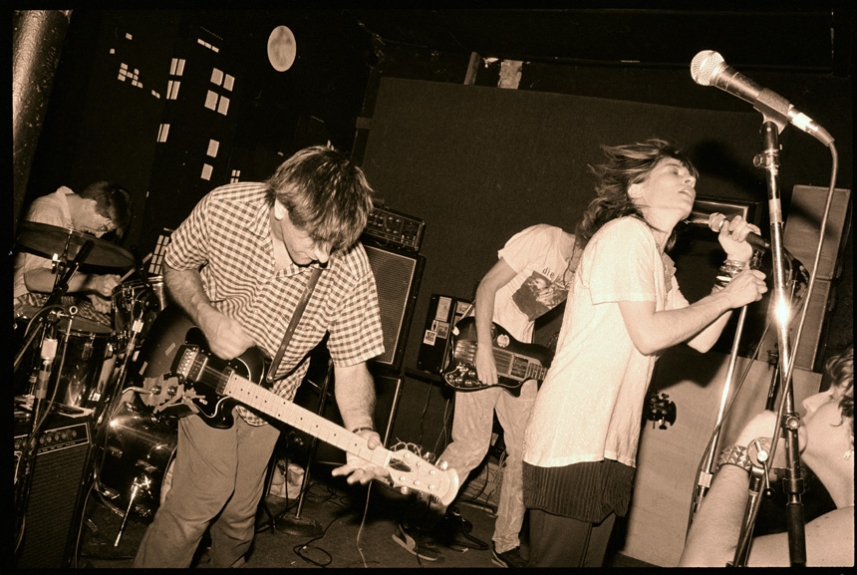Sonic Youth are Steve Shelley, Lee Ranaldo, Thurston Moore and Kim Gordon.
During my years as a music photographer, the two bands I shot the most were the Butthole Surfers and Sonic Youth, possibly because both of them were completely mind-melting performers.
In 1986, at the beginning of their tour to support the EVOL album, Sonic Youth returned to Austin to play the smallish Continental Club for the second time. A tape of their set later became an infamous and allegedly great bootleg record. I took the first photo above on that night, and it's always been one of my most beloved pictures. I'm told it will soon be published in Kim Gordon's autobiography, which I am excited to read....
A few years later, just before the release of their Daydream Nation album, the band played a series of shows in New York and New Jersey to work up their new songs for the longer tours ahead. Using telephoto lenses has always seemed like cheating to me, but when SY played the tiny Maxwell's bar in Hoboken, I was able to make extreme close-ups of the band at work. I was in the right place at the right time.
“What scares me is people who don’t have a sense of history.”
Kim Gordon, 1988
[Sonic Youth] inhabit that weird expanding void where hippie ends and hip starts, a swooning, shabby and temperamental quality…Like an orchestra trapped in a drainpipe.
3 ½ star review of SY's self-titled debut EP, Sounds
[Sonic Youth's] clanging noise over a dance beat is all right if you can take it, but the Contortions are still champs in the funky chaos department.
review of same, Trouser Press, both May, 1982
“[Punk] was like a nihilist hippie movement, that’s all it was.”
Thurston Moore
“In the early eighties, Thurston and Kim were both coming into the record store I worked at before they knew each other. They were buying the same records, and I told them they should probably meet. About a year later, they were inviting me to their wedding.”
Terry Tolkin, former Touch & Go Records executive, and VP of A&R, Elektra Records, 1992-1996
All the principal members of Sonic Youth—Thurston Moore, Kim Gordon and Lee Ranaldo—are featured on a record that is the new issue of Just Another Asshole magazine. Each issue of the “magazine” is different. Sometimes it really is a magazine, sometimes a record, or something else….The record features over sixty tracks, each about forty-five seconds long. The cut “Shift” is a minute of hissing noise by guitarist Lee Ranaldo. Thurston Moore’s track, “The Fucking Youth of Today” starts with a strange little monologue, then a little guitar solo, with dogs barking added. It’s actually very funny and a nice little miniature. Kim Gordon and Miranda’s bit is untitled and but a blip as well….This whole project is a good example of what passes for New York art.
George Gimarc, Post Punk Diary, entry dated December 6, 1981
Although SST partners Greg Ginn, Chuck Dukowski, and Mugger were interested in Sonic Youth, Joe Carducci wasn’t. “Record collectors shouldn’t be in bands,” Carducci is said to have grumbled, and since SST signing decisions had to be unanimous, that was that. But shortly after Carducci left the label in 1986—and legend has it that it was minutes after he left—Ginn called Moore and Gordon and offered to sign Sonic Youth. They quickly accepted.
Michael Azerrad, Our Band Could be Your Life, 2001
“We really like the stance that rap music takes—not necessarily the political stance, but more like the neighborhood stance. Rap is coming right out of the neighborhoods, like modern-day folk music. It’s really music of the city streets. And in a way, I guess we feel close to some of the sonic experimentation going on in that music. They’re using turntables, we’re using guitars, but still it’s all in the quest of a cool-sounding thing.”
Lee Ranaldo, Sonic Youth, 1990
(on recording Goo, the follow-up to Daydream Nation) “I want it to be just the next album. But there’s a lot of pressure—at least it feels like there’s pressure—from the people who are already into us to not fuck up. Because the first major-label album from an underground band is always such a bad experience. Then there’s pressure from ourselves to do well. That’s the biggest and the best pressure—just doing better than your own last record, and screw everything else.”
Steve Shelley, 1990
(on why their band chemistry works) “Well, there’s a girl in the band. Girls are better at communicating. Boys won’t necessarily initiate communication. But no…that’s bullshit. We’re confrontational; you can spend a lot of time getting to know someone, but communicating with people is work.”
Kim Gordon, 1990
